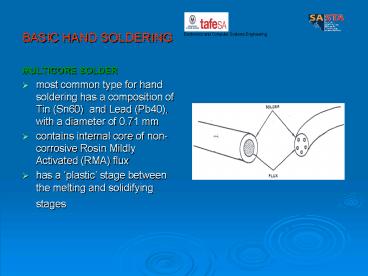BASIC HAND SOLDERING - PowerPoint PPT Presentation
1 / 12
Title:
BASIC HAND SOLDERING
Description:
most common type for hand soldering has a composition of Tin (Sn60) and Lead ... contains internal core of non-corrosive Rosin Mildly Activated (RMA) flux ... – PowerPoint PPT presentation
Number of Views:3803
Avg rating:3.0/5.0
Title: BASIC HAND SOLDERING
1
- BASIC HAND SOLDERING
- MULTICORE SOLDER
- most common type for hand soldering has a
composition of Tin (Sn60) and Lead (Pb40), with
a diameter of 0.71 mm - contains internal core of non-corrosive Rosin
Mildly Activated (RMA) flux - has a plastic stage between the melting and
solidifying stages
2
- Dry joints are caused through
- movement of joint during plastic stage
- thermal stress
- PCB contamination
- oxidisation
BASIC HAND SOLDERING
3
BASIC HAND SOLDERING
- TIPS
- appropriate size and width is determined by the
size of the connection to be made - ideally 2/3 to equal the diameter of the pad
- tips should be correctly 'tinned at all times,
by adding a small amount of solder to the hot tip
4
BASIC HAND SOLDERING
- LEAD FORMING
- minimum distance from the end of the component
body to the start of the lead bend is usually 2
lead diameters or 1.5mm for hand bending methods - without undue pressure hold the component lead
with the pliers and bend the lead protruding
beyond the pliers with a finger until a 90 degree
angle is formed. - if damaged discard component
5
BASIC HAND SOLDERING
- COMPONENT MOUNTING
- Radial leaded loaded slightly off the PCB (0.3 -
3.0mm) - Axial-leaded loaded with the body of the
component very close to the PCB (0.3 - 3.0mm)
6
BASIC HAND SOLDERING
- BENDING AND MOUNTING OF COMPONENTS
- mounted centrally between the holes
- resistors mounted so colour code orientated in
the same direction - polarised components should be orientated so that
polarity symbols ( or - ) and component value
are visible
7
BASIC HAND SOLDERING
- LEAD TERMINATIONS
- TYPE 1 FULLY CLINCHED
- bend the lead flat against the pad
- trim the lead to a length of between 1-2 lead
diameters - Used in High Quality/High Reliability military or
life support applications - difficult to rework
- TYPE 2 SEMI-CLINCHED
- bend the lead to an angle of approx. 45?
- Cut to a minimum of 0.5mm and a max. of 1.5mm, or
between 1-2 lead diameters - Used for commercial applications
- ease of de-soldering
- TYPE 3 RIGID LEAD TERMINATION
- straight through termination
- Cut to a length of min. 0.5mm and max. of 1.5mm,
or between 1-2 lead diameters
8
BASIC HAND SOLDERING
- CONSTRUCTING A GOOD SOLDER JOINT
- Figure a) the amount of solder applied is minimal
and may result in a poor electrical connection
over time. - Figure b) shows the optimal solder joint that has
good wetting between component lead and PCB pad. - Figure c) indicates an excessive amount of solder
has been applied to the connection.
9
BASIC HAND SOLDERING
- CLEANING
- a process of removing contaminates before and
after soldering - ensures good mechanical/electrical connection
- Three different methods
- Mechanical - scourer or bristle brush
- Chemical - solvents eg. Isopropyl Alcohol
- Thermal - solder pot
10
BASIC HAND SOLDERING
- BASIC SOLDERING PROCEDURE
- iron temperature is set at approx. 350?
- soldering iron tip size is suitable
- solder sponge is damp
- tip is clean and shiny (wipe tin)
- Apply flux (RMA) to help wetting if necessary
- soldering iron at a 45? angle
11
BASIC HAND SOLDERING
- BASIC SOLDERING PROCEDURE
- heat the lead and the pad simultaneously
- flowing solder around the joint forms a heat
bridge - remove soldering iron and solder simultaneously
(prevents spiking) - clean the PCB with Isopropyl Alcohol and a
bristle brush - wipe or pat dry with a lint free tissue to remove
traces of residue.
12
BASIC HAND SOLDERING
- Use appropriate safety equipment
- fume extractors
- hand cleaners
- goggles
- READY TO SOLDER































